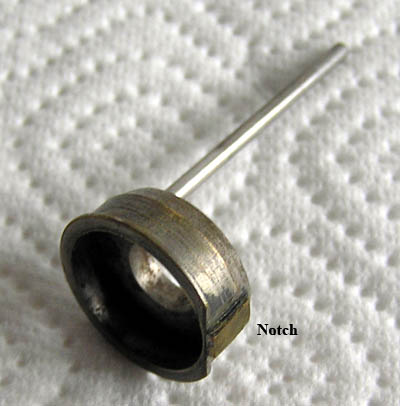Illustrated Anatomy of a Conn Valve, 1930s - 1940s
Part 3: Sticking Valves
Introduction
In this article I will be discussing a way to tackle the problem of sticking valves on Conn instruments
of the 1930's and 1940's. This article deals specifically with Conn cornets and trumpets with serials starting with 3xx,xxx,
but should apply equally to other Conn instruments with serial numbers in that range. I do know that valves on 6A/6B and 10A/10B
Victor models with serials 6xx,xxx and 22B Victors through at least serials Cxx,xxx are very similar to what is described below.
That means that presumably all Victor models with bottom spring valves fall into the category of this article. Director models have different (simpler) valves.
If you haven't yet read part 1 of this article, I suggest you do so first.
The problem of sticking valves
A problem that is, unfortunately, quite common on older Conn instruments is that of one or more of the valves coming up
slowly. This of course usually happens at the most inconvenient moment and is most annoying. In my experience the valves don't stick when they are
simply toggled rapidly, possibly not even on quick passage but often when the affected valve is held down for a while. It is
more liable to be the 3rd valve, possibly because of the position of most people's hand.
Things to check first
First, you need to make sure the problem isn't being caused by dirty valves or valve ports. So the first step is to make
sure the instrument is completely clean and that there isn't any crud (built up oil, slide grease, etc.) in the valve casing
or valve ports. And of course, the valve needs to be oiled normally.
If this doesn't solve the problem (and since you are reading this my guess is it hasn't), check the corks on the valve. If these corks are broken, cracked, if the top or bottom isn't straight that could cause problems too. I have seen corks replaced by cut down wine corks. If the corks are suspect, please check the section in part 1 of this series about replacing valve corks.
The likely culprit
The likely cause of sticking valves is this:

The valve guide. I have found that replacing this can magically cure sticking valves. The first thing to try is to swap the valve guide of the affected valve with another valve. If the problem follows the valve guide, that is a very strong indication that the valve guide is indeed the problem. The problem might disappear completely by swapping the valve guide because your hand position might be different on the other valve.
If you find that the valve guide is indeed the problem and that you need a new one, you of course are faced with a new problem: these valve guides are difficult to find. If you have more than one Conn instrument with this type of valve you could scavenge from one instrument. You could try to pick up a valve guide on eBay, or perhaps an unplayable (! please) instrument for the purpose of scavening. No guarantee of course that this new valve guide will be any better, but if you pick up a junk instrument, at least one valve guide is bound to be good. Here is another unhelpful tip: The "Special" versions of various models (22B, 38A) in my experience have superior quality valves. If you can find a derilict "special" in unplayable condition, it would make the ideal candidate to get valve parts from. You should also be aware that valve guides from different years have slightly different specs. The ones from the mid 1930's have a little less mass and are slightly lower than the ones from the late 1930's and 1940's. I am not sure if the slight change in mass has any effect, but the slight difference in height will affect vertical valve alignment. As long as you are aware of this, it is OK to interchange these valve guides.